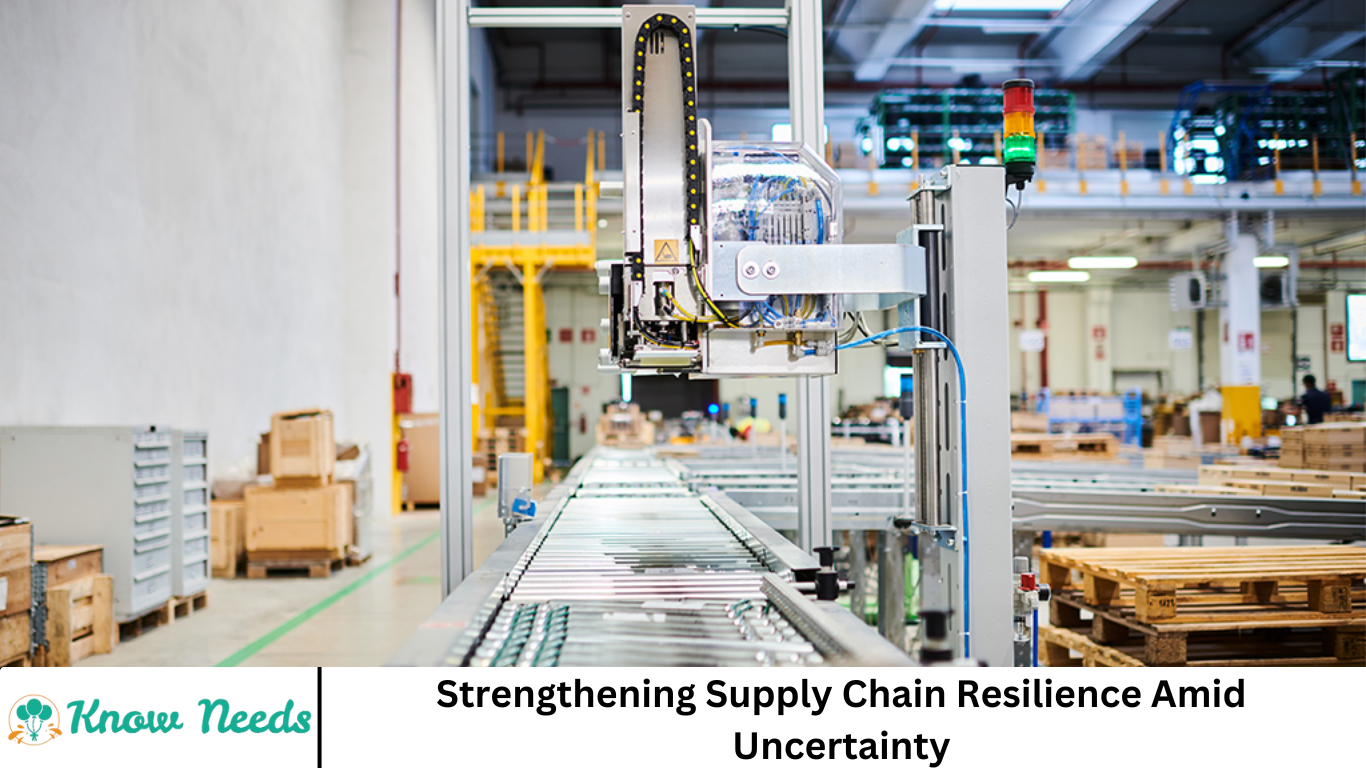In today’s rapidly evolving global marketplace, supply chains face unprecedented challenges. From geopolitical tensions and fluctuating trade policies to economic volatility and technological disruptions, businesses worldwide are navigating an environment filled with uncertainty.
Strengthening supply chain resilience has become not just a competitive advantage but a critical necessity for organizations striving to survive and thrive. This article explores the importance of supply chain resilience, identifies key risks contributing to uncertainty, and outlines actionable strategies companies can adopt to build stronger, more adaptive supply chains.
More Read: Adapting to the New Normal Through Digital Transformation
What is Supply Chain Resilience?
Supply chain resilience refers to a supply chain’s ability to anticipate, prepare for, respond to, and recover from disruptive events while maintaining continuous operations. It encompasses not only the ability to withstand shocks but also to adapt and evolve when faced with new challenges.
A resilient supply chain minimizes the risk of disruptions and ensures operational continuity despite volatility—whether caused by natural disasters, political unrest, pandemics, or sudden market shifts. In contrast, fragile supply chains are vulnerable to breakdowns, resulting in delays, increased costs, and lost customer trust.
Why is Supply Chain Resilience More Critical Now?
1. Geopolitical Tensions and Trade Wars
Trade relations are increasingly strained, as seen in the rise of tariffs, sanctions, and protectionist policies. The U.S.-China trade war and other tariff escalations have disrupted global flows of goods, forcing companies to rethink sourcing and manufacturing strategies.
2. Economic Uncertainty
Global economic instability — driven by inflation, fluctuating currency rates, and unpredictable demand — complicates forecasting and inventory management, increasing the risk of stockouts or overstocks.
3. Regulatory Changes
Rapidly changing compliance requirements across different regions make it harder for supply chains to maintain consistency and agility. Non-compliance can result in costly penalties and supply delays.
4. Technological Disruptions
While digital innovation offers opportunities, it also presents challenges, including cybersecurity threats and the need for continuous system upgrades to maintain smooth operations.
5. Global Pandemic Impact
The COVID-19 pandemic exposed vulnerabilities in global supply chains, from raw material shortages to logistics bottlenecks. Recovery continues to be uneven and uncertain, underscoring the need for robust contingency planning.
The Risks of Ignoring Supply Chain Resilience
Failing to strengthen supply chains against these uncertainties can lead to:
- Operational Disruptions: Delays and stoppages affect product availability and customer satisfaction.
- Increased Costs: Emergency sourcing and expedited shipping inflate costs.
- Reputational Damage: Unreliable supply can erode customer trust and brand loyalty.
- Revenue Loss: Inability to meet demand translates directly into lost sales.
- Strategic Vulnerability: A weak supply chain limits business flexibility and growth potential.
Key Elements of a Resilient Supply Chain
Building supply chain resilience requires a multifaceted approach combining technology, strategy, and people. Key elements include:
1. Visibility and Transparency
End-to-end visibility enables companies to monitor inventory, shipments, and supplier status in real time. Transparent supply chains help identify potential risks early and enable quicker responses.
2. Diversification of Suppliers and Sources
Relying on a single supplier or region is risky. Diversifying sourcing locations and suppliers spreads risk and improves adaptability in case of disruptions.
3. Agile and Flexible Operations
Agility allows companies to quickly adjust production, logistics, and inventory policies in response to changing conditions. Flexibility in contracts and partnerships supports rapid pivots.
4. Risk Management and Scenario Planning
Identifying vulnerabilities and simulating potential disruptions helps organizations prepare contingency plans and allocate resources effectively.
5. Investment in Technology
Advanced analytics, AI, IoT, and blockchain enhance forecasting, traceability, and automation, all critical to resilience.
6. Strong Collaboration and Communication
Close collaboration with suppliers, logistics partners, and internal teams fosters trust, alignment, and rapid problem-solving.
Strategies to Strengthen Supply Chain Resilience
1. Enhance Supply Chain Visibility with Technology
Utilize cloud-based platforms and Internet of Things (IoT) devices to gain real-time insights into inventory levels, transportation routes, and supplier health. Tools like AI-powered predictive analytics can forecast demand shifts and potential disruptions, enabling proactive decision-making.
2. Build a Flexible Supplier Network
Avoid overdependence on any single supplier by qualifying multiple vendors across different geographic regions. Consider nearshoring or reshoring critical components to reduce exposure to global shocks.
3. Implement Scenario-Based Risk Assessments
Regularly conduct “what-if” analyses to understand the impact of various disruptions—from natural disasters to political crises—and develop corresponding mitigation plans.
4. Invest in Inventory Buffers and Safety Stocks
While lean inventory reduces costs, strategic buffers in critical components provide a cushion against supply delays. Balancing inventory investment with risk exposure is key.
5. Strengthen Logistics and Distribution Resilience
Evaluate logistics partners for their reliability and contingency capabilities. Diversify transportation modes and routes to avoid bottlenecks and quickly reroute shipments if needed.
6. Foster Supplier Partnerships and Collaboration
Build long-term relationships based on transparency and mutual benefit. Collaborate on joint risk management initiatives, innovation, and capacity sharing during crises.
7. Adopt Sustainable and Ethical Practices
Sustainability initiatives reduce exposure to regulatory risks and improve brand reputation. Ethical sourcing helps avoid disruptions caused by social or environmental controversies.
8. Train and Empower Supply Chain Teams
Equip teams with the skills and authority to make quick decisions. Encourage cross-functional collaboration to integrate supply chain considerations into overall business strategy.
Case Studies: Companies Successfully Strengthening Supply Chain Resilience
Case Study 1: Apple Inc.
Apple’s diversified supplier base and multiple manufacturing locations allow it to pivot quickly when one region experiences disruption. Its investment in advanced analytics helps optimize inventory and forecast demand accurately.
Case Study 2: Toyota
Toyota’s famous Just-In-Time production system faced challenges during the 2011 earthquake and tsunami. Post-crisis, Toyota introduced more safety stock for critical parts and improved supplier risk assessments, blending lean efficiency with resilience.
Case Study 3: Unilever
Unilever emphasizes supplier collaboration and sustainability. Through its Partner to Win program, the company fosters innovation and risk-sharing with suppliers, strengthening the overall supply network.
Measuring Supply Chain Resilience
To ensure continuous improvement, companies should track resilience metrics such as:
- Time to Recover (TTR): The duration it takes to return to normal operations after a disruption.
- Supply Chain Disruption Frequency: How often supply interruptions occur.
- Supplier Risk Scores: Assessment of supplier reliability and risk exposure.
- Inventory Turnover and Stockouts: Indicators of inventory management effectiveness.
- Customer Satisfaction Levels: Reflecting supply chain impact on end users.
Regular audits and feedback loops ensure these metrics inform strategy updates and investments.
The Future of Supply Chain Resilience
Emerging technologies and shifting global dynamics will continue reshaping supply chains. Key future trends include:
- Digital Twins: Virtual models simulating supply chain operations to predict risks and test scenarios.
- AI-Driven Automation: Enhancing decision-making and operational efficiency.
- Blockchain: Increasing transparency and traceability.
- Circular Supply Chains: Focusing on reuse and sustainability to reduce resource dependency.
- Increased Localization: Balancing globalization with local production to reduce risk.
Organizations that proactively embrace innovation and embed resilience into their culture will be best positioned to navigate uncertainty and capitalize on opportunities.
Frequently Asked Question
What does supply chain resilience mean?
Supply chain resilience refers to the ability of a supply chain to anticipate, respond to, and recover from disruptions—such as geopolitical tensions, natural disasters, pandemics, or economic shifts—while maintaining operations and minimizing negative impacts. Resilient supply chains are agile, adaptable, and capable of withstanding both short-term shocks and long-term uncertainties.
Why is supply chain resilience more important now than ever?
The global business environment is increasingly volatile due to trade wars, inflation, cybersecurity risks, environmental events, and shifting regulations. Events like the COVID-19 pandemic and the Ukraine conflict have exposed how easily global supply chains can break down. As a result, resilience is now a strategic priority for companies aiming to protect profitability, customer satisfaction, and long-term growth.
What are the main risks to supply chains in uncertain times?
Key risks include:
- Geopolitical instability and tariffs
- Supply shortages and transportation bottlenecks
- Regulatory changes across regions
- Currency and economic volatility
- Natural disasters and climate-related events
- Cyberattacks and digital infrastructure failures
These risks can disrupt operations, delay deliveries, and increase costs if not properly managed.
How can companies strengthen their supply chain resilience?
Organizations can enhance resilience by:
- Increasing supply chain visibility through technology
- Diversifying suppliers and sourcing locations
- Building inventory buffers for critical items
- Conducting scenario-based risk planning
- Collaborating closely with suppliers and partners
- Investing in agile, data-driven decision-making systems
These measures help reduce dependence on any single point of failure.
What role does technology play in supply chain resilience?
Technology enables real-time monitoring, predictive analytics, automation, and scenario modeling—all crucial for proactive supply chain management. Tools like AI, IoT, blockchain, and digital twins provide better forecasting, track-and-trace capabilities, and faster response to disruptions.
How can companies measure the resilience of their supply chain?
Common resilience metrics include:
- Time to Recover (TTR) after a disruption
- Supply Chain Risk Exposure score
- Supplier performance and reliability indicators
- Inventory turnover and stockout frequency
- Customer fulfillment and satisfaction rates
Tracking these KPIs helps assess vulnerabilities and guide improvement initiatives.
Is supply chain resilience compatible with cost efficiency?
Yes, but it requires balance. While resilience often involves upfront investment (e.g., safety stock, digital tools, multi-sourcing), it reduces the long-term costs associated with disruptions. Many companies now view resilience not as a cost center but as a value creator—protecting revenue, reputation, and operational continuity.
Conclusion
The era of uncertainty demands supply chains that are not only efficient but also robust, adaptive, and forward-looking. Strengthening supply chain resilience is vital for managing risks, ensuring business continuity, and driving sustainable growth. By investing in visibility, diversification, technology, collaboration, and strategic planning, businesses can transform their supply chains from potential points of failure into competitive assets. The companies that succeed will be those that recognize supply chain resilience as a core component of their long-term strategy.


